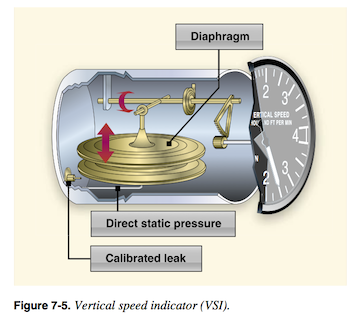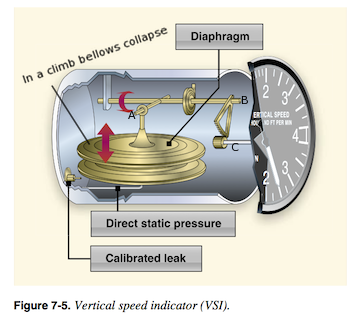Pitot-static Instruments
#1
Will someone look closely at this image from the Pilot's Handbook of Aeronautical Knowledge and tell me if the VSI diagram is incorrect? I'm probably just tired and not seeing it right, but to me the VSI needle would indicate a decent when the aircraft is actually climbing.
As the aircraft altitude increases, the pressure inside the bellows decreases (it's connected to static pressure). The instrument case's pressure should be higher than that of the bellows in a climb so the bellows should collapse right? If my logic is correct then the mechanical linkages in this image appear to be incorrect. What do you think?

As the aircraft altitude increases, the pressure inside the bellows decreases (it's connected to static pressure). The instrument case's pressure should be higher than that of the bellows in a climb so the bellows should collapse right? If my logic is correct then the mechanical linkages in this image appear to be incorrect. What do you think?

#3

So, if you start a climb, pressure inside the instrument case will be higher than that of the bellows causing them to collapse which pulls lever "A" down. With lever "A" being pulled down we can assume that Axel "B" rotates counter-clockwise (as viewed from the front of the instrument). If axel "B" rotates CCW then the teeth rotate axel "C" Clockwise which gives the VSI a "down" indication.
Am I going crazy?

#5
Forgive me if this is incorrect because it's been a while since I've dived into this stuff also.
The diaphragm and the case are both directly connected to the static pressure, therefore in level flight the pressure is equal in both, indication 0 fpm. As you climb, the pressure in the diaphragm decreases. The static pressure inside the case also decreases, but due to the calibrated leak, the pressure decreases at a slower rate. This causes greater differential pressure in the case, compressing the diaphragm which shows a climb in the VSI.
In a descent it's exactly the opposite. The diaphragm expands due to greater static pressure compared to the gradual increase in the case. The expansion then shows a decrease on the VSI.
The diaphragm and the case are both directly connected to the static pressure, therefore in level flight the pressure is equal in both, indication 0 fpm. As you climb, the pressure in the diaphragm decreases. The static pressure inside the case also decreases, but due to the calibrated leak, the pressure decreases at a slower rate. This causes greater differential pressure in the case, compressing the diaphragm which shows a climb in the VSI.
In a descent it's exactly the opposite. The diaphragm expands due to greater static pressure compared to the gradual increase in the case. The expansion then shows a decrease on the VSI.
#6
undflyboy06,
You are correct. This FAA digram is inaccurate. Not that it's a big deal, but it made me second guess myself when someone asked me why the needle shows a decent when the bellows compress for a climb.
I had not touched any of my old books in awhile, but I'm getting back into instructing and discovered that the FAA has all the updated manuals for download on their website. The newer versions of The Pilot's Handbook of Aeronautical Knowledge and the the Instrument Flying Handbook are pretty nice. My old books didn't have any color diagrams, but the new stuff is color and goes into glass cockpit stuff. I'm impressed.
You are correct. This FAA digram is inaccurate. Not that it's a big deal, but it made me second guess myself when someone asked me why the needle shows a decent when the bellows compress for a climb.
I had not touched any of my old books in awhile, but I'm getting back into instructing and discovered that the FAA has all the updated manuals for download on their website. The newer versions of The Pilot's Handbook of Aeronautical Knowledge and the the Instrument Flying Handbook are pretty nice. My old books didn't have any color diagrams, but the new stuff is color and goes into glass cockpit stuff. I'm impressed.
#7
Gets Weekends Off
Joined APC: Aug 2009
Position: C-172 PPL
Posts: 176
Then the teeth rotate axel "C" Clockwise
which gives the VSI a "down" indication.
As currently drawn, the needle is about -2,500 ft per minute.
In a shallowing of the descent, or even a climb, I expect the needle to move closer to 0 FPM.
#8
On Reserve
Joined APC: May 2010
Position: CFI
Posts: 19
As a side note, theoretically if you climbed very very fast and moved beyond the "4" in the clockwise direction, the numbers begin to decrease, and this would appear to be a decrease in descending vertical speed. However, once the calibrated leak equalizes the pressure you would see the needle again swing past the "4" all the way around back to zero in the counterclockwise direction. The mechanical linkage limitations would probably prevent this, but I'm not sure. Ignore this if I've really confused you, it's not 100% relevant to answering your question.
I mean your assumptions are completely correct until you convinced yourself that rotating the needle clockwise is read as a descent. Someone correct me if I've given false info...This stuff can get confusing!
#9
On Reserve
Joined APC: May 2010
Position: CFI
Posts: 19
#10
Ok... I'm an idiot.. I've been reading the diagram wrong this whole time... I've been looking at the 4000 foot mark and interpretting that as the zero indication. The diagram IS right. That's the only mistake I've ever made.  Thank you everyone for your insight.
Thank you everyone for your insight.
 Thank you everyone for your insight.
Thank you everyone for your insight.
Thread
Thread Starter
Forum
Replies
Last Post






